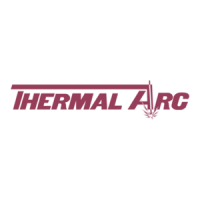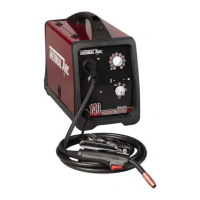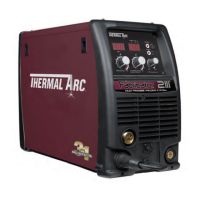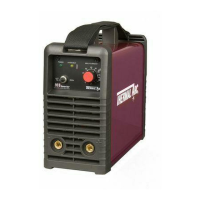What to do if there are gas leaks in my Thermal Arc FABRICATOR 181i?
- JJames AlvaradoAug 18, 2025
If you suspect gas leaks, check the connections between the regulator and the cylinder, and also inspect the gas hose leading to the power source.

What to do if there are gas leaks in my Thermal Arc FABRICATOR 181i?
If you suspect gas leaks, check the connections between the regulator and the cylinder, and also inspect the gas hose leading to the power source.
What to do if there is limited or no shielding gas flows out of the Thermal Arc FABRICATOR 181i's MIG Gun nozzle?
| Input Frequency | 50/60 Hz |
|---|---|
| Wire Feed Speed Range | 50 - 700 IPM |
| Duty Cycle | 30% |
| Welding Processes | MIG, Stick |
| Wire Size Range | 0.023-0.045 in |
Details electrical shock hazards and precautions during arc welding, including proper grounding and cable use.
Covers fire prevention, housekeeping, ventilation, personal protection, and compressed gas cylinder safety.
Lists key safety standards and codes relevant to welding and cutting operations.
Explains symbols used on the equipment for operational and safety information.
Provides safety measures specific to arc welding processes, including personal protective equipment.
Details risks associated with arc welding, including electrical shock, fire, and fumes.
Guide on how to effectively read and understand the manual's content and structure.
Explains how to locate and record essential identification numbers for the equipment.
Instructions for inspecting equipment upon delivery for completeness and shipping damage.
Overview of the Fabricator 181i's capabilities and features as a multi-process welding system.
Safe procedures for moving the welding power source, including lifting and securing.
Outlines user obligations regarding proper installation, operation, maintenance, and modification.
Lists all components included in the Fabricator 181i Portable System Package.
Explains the concept of duty cycle and its application to the welding power source's performance.
Detailed technical specifications for the Fabricator 181i welding system.
Lists available optional accessories and their corresponding part numbers.
Defines suitable environmental conditions for operating the power source, considering electrical shock hazards.
Guidelines for selecting an appropriate operating location, considering ventilation and environmental factors.
Emphasizes the importance of adequate ventilation to remove welding fumes and gases.
Specifies voltage requirements and potential issues with incorrect supply voltage.
Addresses potential electromagnetic interference and user responsibilities for mitigation.
Instructions on connecting, operating, and testing the Victor gas pressure regulator.
Procedure for safely testing gas systems for leaks before operation.
Steps for properly shutting down and depressurizing the gas regulator system.
Guidelines for storing the gas regulator when it is not in use to protect it.
Detailed explanation of the front and rear panel controls, indicators, and their functions.
Step-by-step guide for connecting the MIG gun to the power source.
Instructions for fitting a 4" wire spool onto the wire feed hub.
Instructions for fitting an 8" wire spool onto the wire feed hub.
Procedure for threading welding wire into the wire feed system.
How to adjust the pressure of the feed rollers for optimal wire feeding.
Steps for replacing the wire feed rolls.
Adjustment of the wire reel brake for proper tension and wire control.
How to operate the gas regulator, including flow rate adjustment and shutdown.
Guide for setting up the machine for MIG welding with gas shielded wire.
Guide for setting up the machine for MIG welding with flux-cored wire.
Instructions for setting up the machine for spool gun MIG welding.
Guide for setting up the machine for TIG welding using the lift start method.
Guide for setting up the machine for Stick welding.
Explains the fundamental techniques for MIG and Flux Cored Arc Welding processes.
Addresses common problems encountered during MIG/FCAW welding, focusing on porosity and wire feed.
Covers electrode size, storage, polarity, and basic techniques for Stick welding.
Discusses how different materials affect stick welding and how to manage those effects.
Explains the causes of distortion during welding and methods to minimize its effects.
Provides solutions for common issues encountered during Stick welding.
Introduces the TIG welding process, electrode types, and filler wire selection.
Offers troubleshooting guidance for common problems in TIG welding.
Lists common power source faults, their causes, and recommended remedies.
Outlines schedules and procedures for inspection, testing, and calibration of the power source.
Instructions for cleaning the internal components of the welding power source.
Guidance on cleaning the drive rollers in the wire feed mechanism.
Displays voltage-amperage output characteristics for different welding modes.
Lists part numbers for essential spare components of the Tweco WeldSkill 180A MIG Gun.
Provides a detailed list of part numbers for the internal components of the welding power source.











